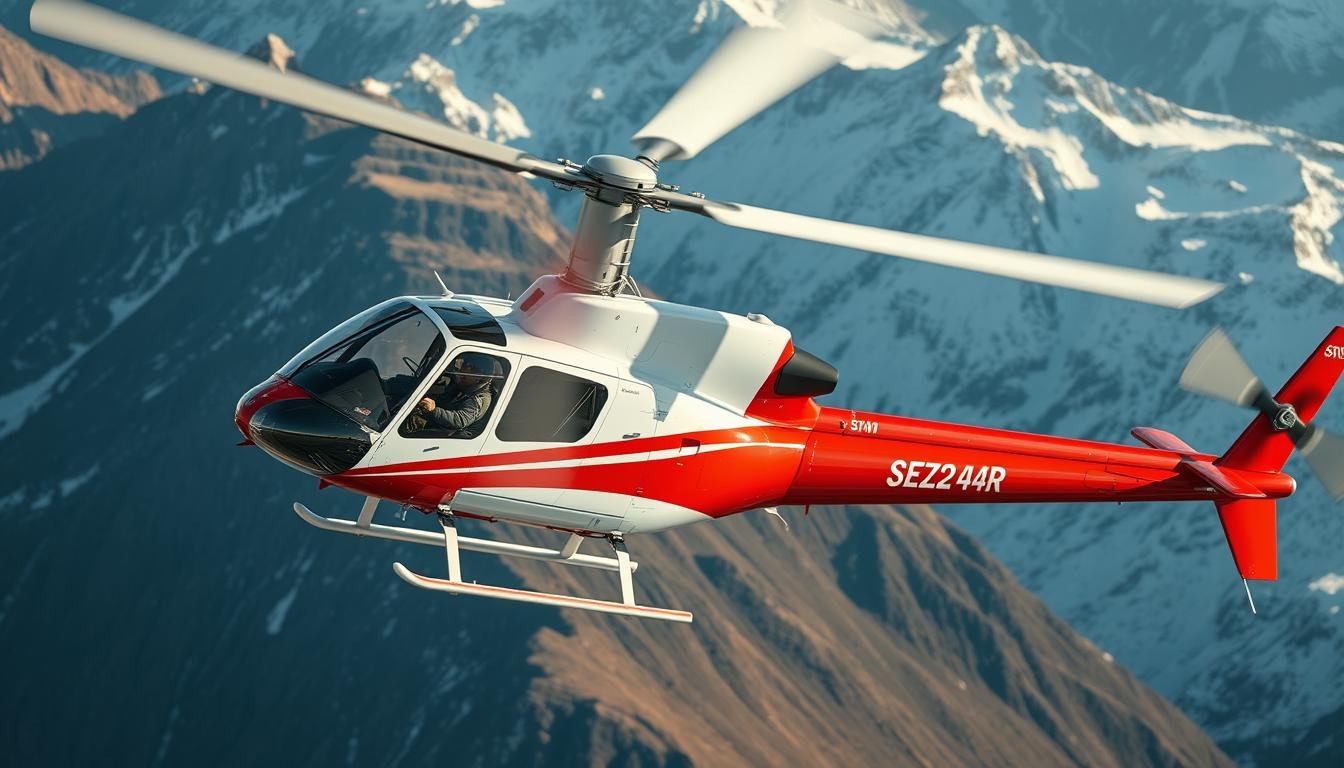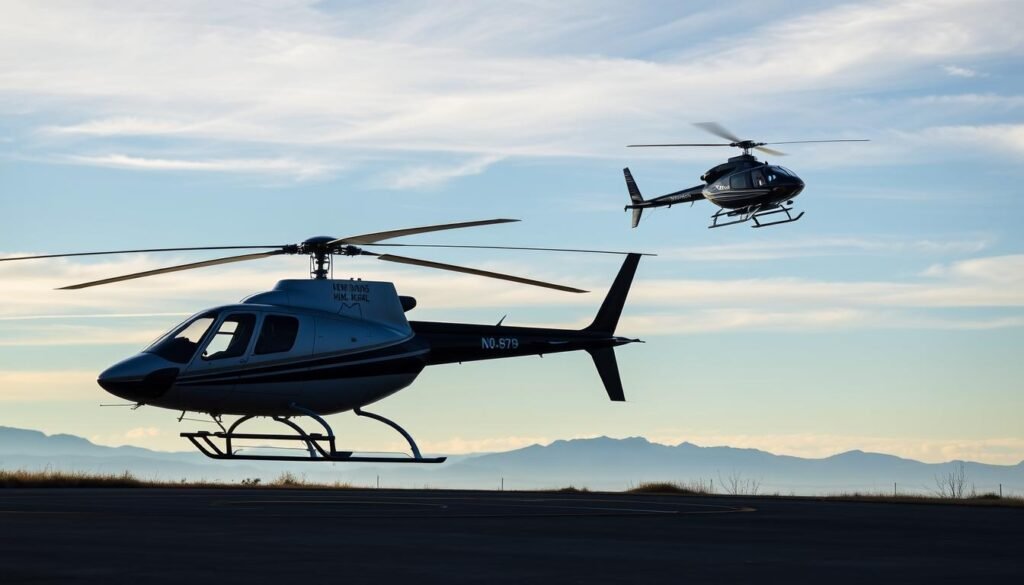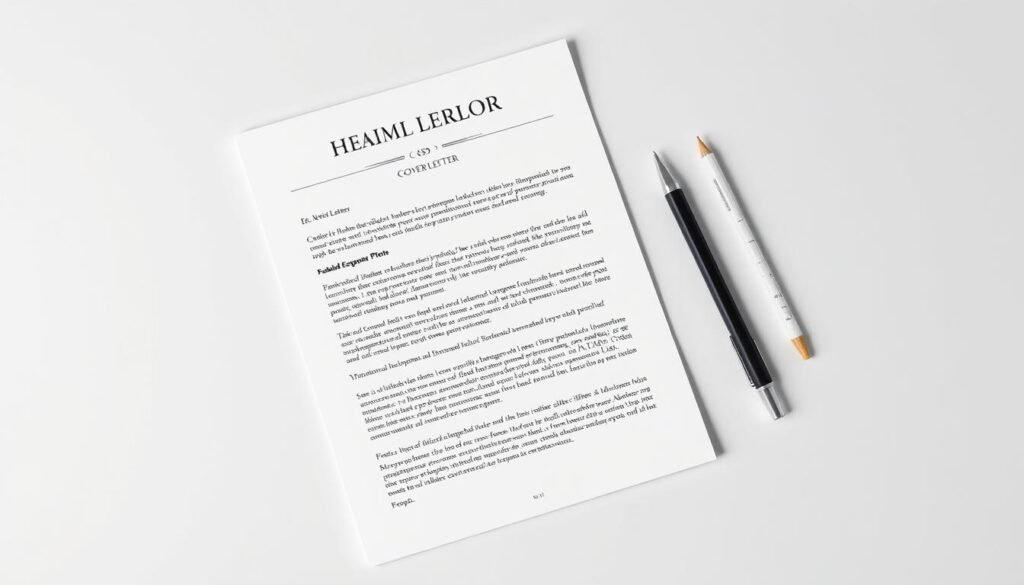An active-duty crew chief turned aviator once stepped from a hangar into a civilian ramp and found opportunity in unexpected places. They used military training to move quickly into roles across emergency medical services, offshore support, and public safety. The transition felt natural because core tasks—pre-flight checks, mission planning, and strict safety routines—were already second nature.

This guide maps a clear way to a rewarding aviation career. It outlines the requirements to go commercial, how experience converts, and which employer types hire most. Veterans will see how service records and turbine time can unlock higher pay and niche opportunities.
Readers will get practical next steps, salary context, and job sources. For a closer look at pay progression and how experience changes earnings, see a detailed breakdown of pilot salary stages.
Key Takeaways
- Military experience accelerates entry into civil aviation roles.
- Commercial licensing, instrument rating, and medical certification are essential.
- Mission types span EMS, offshore, firefighting, law enforcement, and more.
- Pay scales rise with hours, ratings, and specialized turbine experience.
- GI Bill and credential conversion programs help bridge military to civilian pathways.
Why Veterans Are In Demand For Search And Rescue Aviation Roles
Veterans bring mission-ready skills that civilian rescue aviation units prize. Their service background creates a reliable foundation for high-stakes operations and makes many a natural fit for public safety careers in aviation.
Military Skill Sets That Transfer To Civilian SAR Missions
Military training produces disciplined mission planning, precise radio and navigation proficiency, and strict safety compliance. These skills map directly to emergency medical services, firefighting, and law enforcement aviation roles.
Proven crew coordination and checklist discipline reduce risk during time-critical missions. Experience with intelligence-driven tasks also improves surveillance and rapid decision-making in multi-agency operations.
Future Opportunities In U.S. Rescue And Public Safety Operations
Demand grows as states build aviation units and wildfire response expands. Veterans often receive hiring preference for government aviation roles and can use GI Bill benefits to upgrade ratings and earn targeted certifications.
- Cross-functional teamwork boosts coordination with law partners and EMS teams.
- Advanced training and turbine experience open leadership-track roles and specialist careers.
- For industry pathways beyond passenger work, see best industries for advanced aviation careers.
SAR Helicopter Pilot Jobs For Veterans
Veterans often step into high-tempo rescue roles where clear procedures and fast judgment matter most. The next section outlines the primary missions they will fly, routine duties, and the experience employers prioritize.
Primary Missions: Rescue, Medical Evacuation, And Surveillance
Civil aircraft missions span search and rescue, medical evacuation, law enforcement support, firefighting, offshore work, and utility lifts.
Rescue crews operate in varied terrain and weather, handling urgent medical transport and surveillance that supports incident commanders.
Typical Duties: Pre-Flight, Mission Planning, And Safety Compliance
Day-to-day tasks center on safety. Crews perform thorough pre-flight inspections and aircraft performance calculations.
They manage radio calls, navigation, and coordination with dispatch, hospitals, and ground teams to keep missions synchronized.
Preferred Experience: Instrument Rating, Turbine Time, And Mission Hours
Employers prefer candidates with an instrument rating and turbine time on similar airframes. Logged mission hours and documented currency speed hiring decisions.
- Instrument rating ensures competence in low-visibility and IFR procedures.
- Turbine time signals readiness for larger, multi-crew operations.
- Surveillance experience improves target acquisition and sensor integration.
Veterans with combat and contingency experience often show superior judgment under pressure. To explore career pathways and hiring opportunities, see career opportunities and read about common operational challenges at emergency operations challenges.
Directory Of Aviation Roles And Missions Veterans Can Pursue
Veterans can find a wide array of aviation assignments that align with mission skills and career aims. This directory lists common role types and what each position demands in the field.

Emergency Medical Services And Firefighting Operations
EMS and firefighting positions prioritize rapid response and precise aircraft handling.
They include patient transfer, aerial water drops, and crew transport. These roles train operators in tight maneuvers and mission planning under pressure.
Law Enforcement, Border, And Public Safety Aviation
Law enforcement aviation blends surveillance and coordination with ground teams.
Surveillance and intelligence collection support pursuits, border patrol, and public safety missions.
Utility, Construction, And Powerline Support
These positions require external load work and detailed infrastructure inspection.
They demand exact aircraft control and strong risk management for safe lifts and surveys.
Tourism, Corporate Transport, And Offshore Oil & Gas
Tourism and corporate roles focus on passenger safety and schedule reliability.
Offshore positions move personnel to rigs and need solid instrument and overwater procedures.
- Candidates should match their experience to company insurance and contract minimums.
- Many positions develop complementary skills useful in rescue missions, such as hoist and NVG procedures.
- Aircraft selection varies by mission from light utility to medium-lift platforms.
Who Hires SAR And Helicopter Pilots In The United States
A broad mix of public and private employers recruit experienced crews to meet seasonal and mission-driven aviation needs.

Government Agencies: U.S. Forest Service, Customs & Border Protection
Federal and state agencies hire crews to fight wildfires, patrol borders, and support public safety across varied location profiles.
These units value mission currency, multi-agency coordination skills, and a strong service background when filling positions.
Private Operators, Medical Transport, And Defense Contractors
Private aviation companies and medical transport providers staff aircraft for EMS response, interfacility transfer, and contracted search support.
Defense contractors and offshore firms hire staff for training, logistics, and crew movement; many prefer candidates with clearances and turbine experience.
| Employer Type | Typical Missions | Hiring Priorities |
|---|---|---|
| Government Agencies | Wildfire suppression, border surveillance, public safety | Mission readiness, safety record, interagency skills |
| Medical & Private Operators | EMS response, transfers, SAR contracts | Instrument proficiency, turbine time, patient care coordination |
| Defense & Offshore | Training, logistics, crew transport to rigs | Security clearance, background, aircraft type experience |
| Law Enforcement & Tourism | Airborne patrols, sightseeing, tactical support | Officer training, surveillance experience, customer safety |
Note: Applicants to Air Force aircrew roles must pass a selection board, meet vision and medical standards, and clear height screening for compatible aircraft types.
Requirements, Ratings, And Military-To-Civilian Pathways
A focused roadmap of certifications and documented time helps former service aircrew match civilian hiring standards fast.

FAA CPL-H, Flight Time, Medical, And Instrument Rating
Applicants ’ll need an FAA Commercial Rotorcraft License (CPL-H), a second-class medical, and usually an instrument rating.
Typical flight time ranges between 150 and 200 hours for basic commercial work. Turbine time is often required for larger aircraft and EMS or offshore missions.
License Conversion And GI Bill Advantages
License conversion pathways help translate military qualifications into civilian certificates. The GI Bill can fund additional training and rating upgrades.
Documenting hours and current checkrides speeds conversion and improves hiring prospects. For openings and application details see a dedicated listing of helicopter pilot jobs and compare training costs and schools.
Air Force And Army Aviation Standards, Ages, And Fitness
Air Force candidates must pass the AFOQT, meet vision and health rules, hold or be within 365 days of a BA/BS with GPA ≥2.5, and apply before age 33.
Army Aviation offers WOFT as a school-to-cockpit path; flight training is funded but includes a 10-year service obligation after graduation.
| Path | Key Requirements | Typical Commitment |
|---|---|---|
| FAA Civil | CPL-H, 2nd-class medical, instrument rating, 150–200 hrs | Variable — employer minimums apply |
| Air Force | AFOQT, vision/health standards, BA/BS or within 1 year, age limit 33 | Service obligations per commissioning rules |
| Army (WOFT) | Age 17–34, citizenship, aptitude test, medical/fitness | 10-year aviation service obligation after flight school |
Compensation, Flight Pay, And Benefits Outlook
Understanding base salary ranges helps candidates weigh offers by mission, location, and aircraft class.

Base Salary Ranges By Experience And Specialty
Entry-level crews with 500–1,000 hours commonly see a base salary between $40,000 and $60,000.
Experienced operators with 2,000+ hours typically earn $70,000–$100,000 base.
Specialty types such as offshore, EMS, and VIP roles often range $90,000–$150,000+.
Average Pay Benchmarks And Total Compensation Factors
The national average base salary is about $101,000 and serves as a useful benchmark when evaluating offers.
- Total compensation includes flight pay, per diem, allowances, overtime, and health benefits.
- Military service pay increases with years in grade; Warrant Officers may move from roughly $39,000–$54,000 early to about $69,000 by year eight, plus allowances.
- Employers may adjust pay by aircraft complexity, instrument use, standby commitments, and documented mission time.
Candidates should assess the whole package, not just headline salary, and review market pay trends when negotiating.
Training, Education, And Recruiter-Guided Application Steps
Coordinated training milestones and recruiter support turn certification goals into hire-ready qualifications. This section lays out concrete steps from high school pathways to service-funded flight programs and where to apply.

From High School To Flight School: Army Aviation Pathways
The Army offers a direct route via Warrant Officer Flight Training (WOFT). High school graduates who qualify can enter a funded flight program in exchange for a 10-year service commitment.
Applicants ’ll need citizenship or permanent residency, meet age rules (about 17–34), pass aptitude tests, and complete medical and fitness screens. Recruiters guide candidates through paperwork and timelines.
Air Force Academic, Vision, And AFOQT Considerations
Air Force applicants must schedule the AFOQT and confirm academic standing. Candidates need a BA/BS (or be within 365 days), a GPA near 2.5, and must apply before age 33.
Medical and vision standards are strict; working with a recruiter speeds appointment booking and eligibility checks.
Where To Apply: JSFirm, HeliJobs, JustHelicopters, HireVeterans
Use trusted sites to find open positions by mission, aircraft, and location. Set alerts and tailor applications to each posting.
- Plan: Build a training and education timeline that aligns instrument and turbine transition milestones with employer needs.
- Document: Log flight hours, ratings, and checkrides in employer-ready formats.
- Network: Recruiters and training providers help translate military time into civilian equivalencies and push referrals.
For structured flight programs and conversion training, review an established training resource at fixed-wing and conversion training.
Conclusion
A clear endgame helps service aircrew turn ratings and hours into steady civilian flight work. Veterans can use license conversion and GI Bill funding to meet employer requirements and advance training quickly.
Demand across EMS, firefighting, law enforcement, tourism, utility, and offshore sectors supports a strong pay outlook. The average base salary sits near $101,000, with higher pay for specialty missions and leadership roles.
Officers and enlisted candidates should finalize a year-by-year plan that maps checkrides, recruiter contacts, and applications by location. For a practical case study on military-to-civilian transition and industry realities, read this military-to-civilian case study.
Next step: document experience, stay current on ratings, and engage a recruiter to align qualifications with target roles and timelines.
FAQ
What makes veterans strong candidates for search and rescue aviation roles?
Veterans bring disciplined decision-making, mission planning experience, and exposure to austere environments. Their military background often includes crew coordination, survival training, and operations under pressure that translate directly to rescue, medevac, and surveillance missions in civilian and government agencies.
Which military skills transfer best to civilian rescue and public safety flying?
Instrument flying, turbine engine experience, crew resource management, and navigation in degraded conditions are high-value skills. Experience with hoist operations, night vision devices, and tactical communication systems also makes candidates competitive for emergency medical services, firefighting, and law enforcement aviation roles.
What future opportunities exist in U.S. rescue and public safety aviation?
Growth areas include wildfire suppression, coastal search and rescue, border security support, and interagency medevac contracts. Advances in night-vision technology and increased funding for disaster response create demand for experienced aviators in federal, state, and private sectors.
What are the core missions for rescue and medevac aircraft in civilian roles?
Primary missions include personnel rescue, medical evacuation, aerial surveillance, and casualty transport. Operators also conduct hoist rescues, long-range overwater operations, and support for law enforcement and disaster relief efforts.
What typical duties can pilots expect during a mission cycle?
Duties include preflight inspections, mission planning and risk assessment, weather and NOTAM briefings, crew briefings, in-flight systems management, and post-mission debriefs. Pilots must also ensure regulatory compliance and maintain logs and maintenance liaison.
Which experience and ratings do employers prefer?
Employers favor candidates with an FAA commercial rotorcraft certificate, instrument rating, turbine time, and specific mission hours such as night, NVG, and hoist operations. Rescue organizations value multi-crew coordination and lifesaving mission experience.
What civilian roles and missions are available to former military aviators?
Options include emergency medical services, firefighting, law enforcement aviation, border and coastal patrol, utility and construction support, offshore transport for oil and gas, corporate shuttle work, and tourism flights. Each role has distinct training and operational profiles.
Which U.S. agencies and employers hire rescue and utility aviators?
Major employers include the U.S. Forest Service, Customs and Border Protection, state departments of natural resources, private air ambulance companies, defense contractors, and specialized charter operators. Nonprofits and municipal agencies also recruit experienced crews.
What FAA certifications and medical standards are required?
Typical requirements are a Commercial Pilot License for helicopters (CPL-H), an instrument rating, and a current FAA medical certificate (Class II or Class I depending on employer). Minimum flight time thresholds vary by operator and mission type.
How can veterans convert military qualifications to civilian licenses?
Veterans can use FAA military credit pathways, complete required practical tests, and document logged flight time. Programs through VA benefits and Department of Veterans Affairs education funding often cover flight training and testing costs.
What are typical base salary ranges and compensation factors?
Base pay varies by mission, operator, and location. Entry-level medevac or utility pilots may start at modest salaries, while experienced turbine and NVG-rated aviators can earn substantially more. Total compensation often includes per diem, hazard pay, shift differentials, and benefits like health insurance and retirement.
How do total compensation benchmarks differ by specialty?
Offshore and corporate transport roles often offer higher base rates and per-trip pay. EMS and firefighting positions may include overtime, call pay, and state pensions. Contract and government positions can provide stable benefits and long-term retirement options.
What training and education paths lead into aviation careers after service?
Routes include collegiate aviation programs, FAA flight schools, and military transition programs. Veterans frequently use the GI Bill for flight hours, type ratings, and instrument training. Networking through veteran-focused job boards accelerates hiring prospects.
What Air Force and Army standards affect transition timelines?
Service-specific standards for flight physicals, age limits for certain ratings, and time-in-service requirements can influence conversion timelines. Maintaining fitness, up-to-date flight records, and medical documentation streamlines the transition process.
Where should veterans apply to find aviation openings?
Job boards and industry sites such as JSFirm, HeliJobs, JustHelicopters, and HireVets list openings. Applicants should also contact regional operators, medical transport companies, government hiring centers, and defense contractors directly.
How does prior combat or operational experience affect hiring?
Operational experience often signals strong risk management, mission focus, and leadership under stress. Employers prize aviators who have flown complex missions, managed crew coordination, and demonstrated reliability in high-stakes environments.
What nonflying qualifications improve an applicant’s prospects?
Skills in maintenance coordination, avionics troubleshooting, mission planning, and emergency medicine increase versatility. Certifications in CPR, tactical flight surgeon courses, or aircraft rescue techniques can make candidates more attractive.
Are there age or fitness concerns for applicants transitioning from military service?
Most civilian operators require a current FAA medical certificate and fitness for duty. Some roles set age limits for initial hire or require ongoing fitness testing for safety-sensitive missions like fire suppression and hoist work.
How can veterans connect with recruiters and hiring managers?
Veterans should engage with industry recruiters, attend job fairs, join professional associations, and use LinkedIn to highlight flight records and mission experience. Veteran-oriented hiring programs and transition offices can provide direct introductions.



